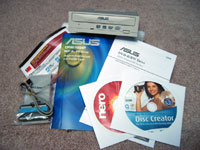Dual-Layer DVD Burner Roundup
It used to be the case that the fastest optical drive was, by default, the best. Reducing CD burn times from 12 minutes to eight and then to six was considered significant evolutionary progress. But then a barrier was encountered, where the imperfect nature of mass-produced compact discs precluded, or at least made it much more difficult, to spin them faster than 52x. Rather than risk spontaneously disintegrating media, drive manufacturers have since focused their attention elsewhere. After all, we'd tend to agree that a polycarbonate saucer spinning in excess of 10,000 rotations per minute next to our knees is plenty, thank you.
So, now we have DVD burners flying along at 16x, or roughly 22MB per second, and it's said that we won't see those devices spin much faster either. Not that we'd be disappointed otherwise since it's already possible to fill a 4.7GB DVD in about six minutes.
The big focus today centers on accelerating the performance of dual-layer drives and media until Blu-Ray and HD-DVD technologies become more prevalent. That's a particularly good thing, too, because the first generation of DL (dual-layer) hardware was aggravatingly slow, often occupying the better part of an hour to fill a single 8.5GB disc. And don't even get us started about the prices of blank DL media. Fortunately, those prices are slowly eroding and it's now possible to get a pack of three discs for about $30. They're still a far cry from the $.50 per blank DVD-R that you can find online, but forward progress nonetheless.
Performance is improving as well. The fastest DL drives write at 5.5MB per second (4x) or almost twice as fast as the 2.4x drives they replace. Further, single-layer speeds persist at 16x and the best hardware even burns standard CDs at 48x. Though not quite 52x, that'll certainly suffice.
Today, we have a collection of five, cherry-picked (by us, not the manufacturers) DL DVD writers at several different price inflections and with a number of performance characteristics. They're all armed with the latest firmware files and ready to battle, so if you've been holding off on a new optical drive, we're giving you the opportunity to compare software packages, burn speeds, and prices.
| |
|
|
ASUS leverages its experience as a motherboard manufacturer to include a reasonable bundle with its latest DL DVD drive. There's an easy-to-follow quick installation guide, a more complete users manual, mounting screws, all of the necessary cabling, and a pair of CDs with Nero 6 OEM Edition, which can be upgraded though Nero's website, and Ulead DVD MovieFactory 3 Suite SE. It would have been nice to see some sort of DVD playback software as well, but perhaps we should just be thankful that ASUS included Nero instead.
Most optical drive manufacturers are fairly conservative when it comes to design and ASUS is no exception. The front panel is beige - par for the course - and the back boasts IDE, power, and analog audio connections, in addition to a jumper block for configuring the drive's IDE status.
There are a few unique features that ASUS lists in its specification sheet, including FlextraLink, FlextraSpeed, DDSSII, and LCT technology. FlextraLink is essentially a marketing name for buffer under-run support. All drives come with it nowadays and you shouldn't expect anything less. FlextraSpeed allows the drive to make write adjustments to compensate for the variable qualities of media. According to ASUS, this has the effect of reducing noise, prolonging the motor's life, and conserving CPU resources. DDSSII is ASUS' patented anti-vibration technology that stabilizes the pickup head both vertically and horizontally for more precise tracking. And finally, LCT (liquid crystal tilt) purportedly improves the pickup head's accuracy on substandard media.
The ASUS drive is a little more expensive than the value drives in our roundup, and while it performs admirably in DL DVD tests (it posted the fastest times in our tests), 32x CD writing speeds put the DRW-1604P about a minute behind the fastest competition. You'll have to decide if the $75 asking price is worth that trade-off.












